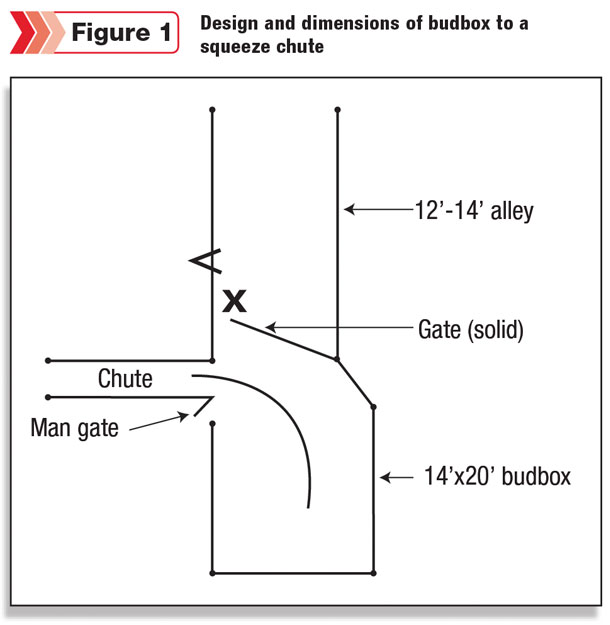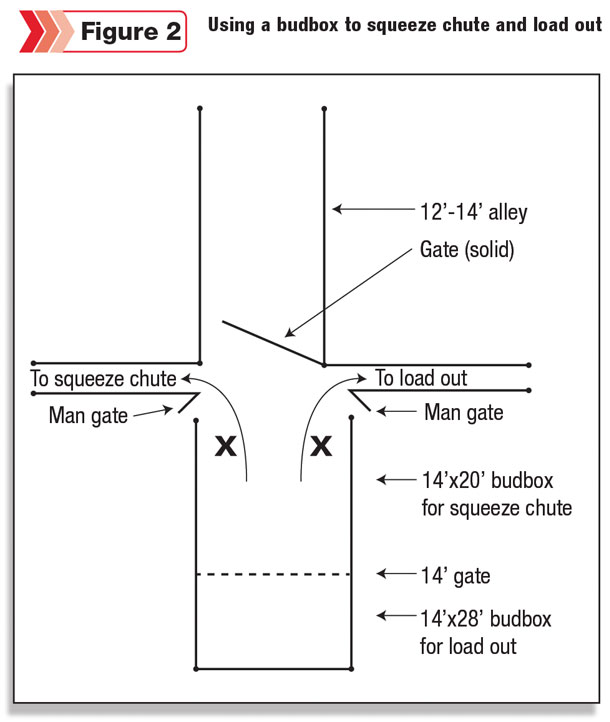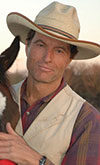Principles
Unlike any other crowd pen design, including the tub, the budbox is unique in how it makes our idea the animals’ idea so they are willing to do what we want, whether going up the chute to the squeeze, up the loading dock into the truck or onto the scale.
As Bud would say, “They get what they want, and we get what we want.” It does so by obeying certain natural animal behavior principles. As articulated by Bud, these principles are:
1. Under excess pressure, animals want to go back where they came from.
2. Animals want to see what’s pressuring them.
3. Animals want to go around you.
Design

Figure 1 depicts the standard design and dimensions of a budbox used for going to a squeeze chute. Bud found that the ideal size is 14 feet by 20 feet.
Note that the gate latches on the side closest to the chute so the entry is as close as possible to the exit (i.e., the chute). All sides are open except the budbox gate.
The man gate allows for easy and quick escape from the box for safety or to get in position to work the box from the outside (which is advisable if the handler considers it unsafe to be inside the box). The X denotes handler position, and the arrow denotes cattle flow.

Budboxes can be designed with two exits for dual purpose (e.g., going to a loadout in addition to the squeeze chute). However, budboxes used to load trucks need to be longer to accommodate more cattle (i.e., 28 feet long) but still only 14 feet wide.
“Any wider than that,” according to Bud, “and the handler will get out in the middle too far and it won’t work as well.” The X’s denote handler position, and the arrows denote cattle flow.
To incorporate the 14-by-20-foot box within the 14-by-28-foot box, the longer box can be fitted with a 14-foot gate at the 20-foot line. That way the size of the box can be easily changed as needed.
Operation
In accordance with the three principles enumerated above, when animals come into the budbox, they will feel the excess pressure of the person behind them when they hit the end of the box and realize they can’t go any further. At that point, they will want to go back where they came from.
Additionally, they want to see what’s pressuring them, and they want to go around you – that’s because they want to keep their eye on you. (Animals are very uncomfortable with turning their backs to a threat.)
Therefore, the handler should stand right inside the box where the X is on the diagrams, and that puts the cattle right at the entrance to the chute. In essence, proper operation of a budbox results in a mind change in which the animals want to go up the chute willingly – no force necessary.
Do’s
1. Do bring animals into the tub with some momentum.
2. Take up the proper position and stay there. Since the animals will feel your pressure and want to go back where they came from, want to see what’s pressuring them and want to go around you (Bud’s three principles), it will pull them right around you and into the chute (or up the loading dock).
3. The single-file chute leading to the squeeze should be nearly empty before feeding the budbox or else you lose the momentum. Ideally, the timing is such that when the budbox is refilled there’s one critter in the squeeze and one waiting to enter, which serves as a draw for the cows entering the chute.
4. The budbox and chute should have open sides because animals will feed easier if they can see out, and an outside handler can use body position to facilitate movement.
5. Only one person should be in position to work the chute, and he or she should be on the “inside” arc. Nobody should be on the “outside” arc.
6. When you bring cattle into the budbox, you have to pause for a few seconds to give them a chance to decide to turn around. According to Bud, “You must let them turn to face the chute before applying pressure.”
Don’ts
1. Don’t do anything to scare the animals (e.g., no yelling or waving of arms). Use position only.
2. Don’t go around behind the animals in the budbox to push them out – that violates the principles and it won’t work well.
3. Don’t use a flag or paddle because it takes the animals’ minds off what and where you want them to go.
4. Don’t put more animals in the box than what the chute will hold, and don’t fill the box more than half-full.
5. Don’t have dogs around.
Conclusion
The budbox is simple in design, easy and cost-effective to build, simple to operate and extremely effective in loading squeeze chutes, trucks and scales.
Additionally, they can usually be retrofitted into existing facilities to facilitate processing cattle, and easily incorporated into portable corral systems. ![]()
Whit Hibbard is a freelance writer based in Montana.







